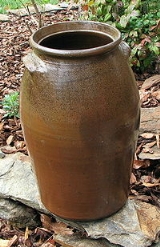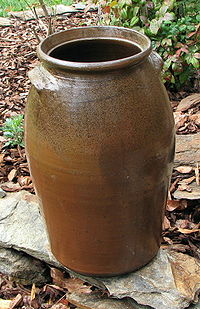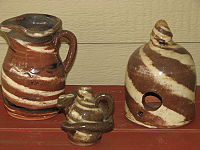
Catawba Valley Pottery
Encyclopedia

Catawba
Catawba may refer to several things:*Catawba , a Native American tribe*Catawban languages-Botany:*Catalpa, a genus of trees, based on the name used by the Catawba and other Native American tribes*Catawba , a variety of grape...
River Valley of Western North Carolina
North Carolina
North Carolina is a state located in the southeastern United States. The state borders South Carolina and Georgia to the south, Tennessee to the west and Virginia to the north. North Carolina contains 100 counties. Its capital is Raleigh, and its largest city is Charlotte...
from the early 19th century, as well as certain contemporary pottery
Pottery
Pottery is the material from which the potteryware is made, of which major types include earthenware, stoneware and porcelain. The place where such wares are made is also called a pottery . Pottery also refers to the art or craft of the potter or the manufacture of pottery...
made in the region utilizing traditional methods and forms.
The earliest Catawba Valley pottery was earthenware
Earthenware
Earthenware is a common ceramic material, which is used extensively for pottery tableware and decorative objects.-Types of earthenware:Although body formulations vary between countries and even between individual makers, a generic composition is 25% ball clay, 28% kaolin, 32% quartz, and 15%...
made by settlers of German
Germans
The Germans are a Germanic ethnic group native to Central Europe. The English term Germans has referred to the German-speaking population of the Holy Roman Empire since the Late Middle Ages....
descent who established farming communities in the region. By the early 1820s, however, Catawba Valley potters had adopted stoneware
Stoneware
Stoneware is a vitreous or semi-vitreous ceramic ware with a fine texture. Stoneware is made from clay that is then fired in a kiln, whether by an artisan to make homeware, or in an industrial kiln for mass-produced or specialty products...
technology that allowed for the manufacture of stronger, larger and more varied wares. Artisans made utilitarian wares needed by the local farming community, such as churns, molasses and whisky jugs and food storage vessels of various sizes. Any decoration was simple, usually limited to one or more incised lines.
At the turn of the 20th century the food industry began to rely increasingly on glass and canned food storage along with refrigeration. These innovations brought about a severe decline of the utilitarian pottery industry nationwide, including the pottery community in Catawba Valley. Potters who chose to continue the craft had to rely on tourism and an interest in handmade crafts fostered by the American Arts and Crafts movement
Arts and Crafts movement
Arts and Crafts was an international design philosophy that originated in England and flourished between 1860 and 1910 , continuing its influence until the 1930s...
. Innovations included decorative techniques such as “swirl ware” ; pottery made by combining two or more different colors of clay. They also introduced unique forms such as “face jugs”. The origin of this form is obscure, but it may be derived from traditional German pottery forms such as the Bartmann jug
Bartmann jug
A Bartmann jug , also called Bellarmine jug, is a type of decorated stoneware that was manufactured in Europe throughout the 16th and 17th centuries, especially in the Cologne region in what is today western Germany...
. Face jugs became, and continue to be, popular with collectors of folk art
Folk art
Folk art encompasses art produced from an indigenous culture or by peasants or other laboring tradespeople. In contrast to fine art, folk art is primarily utilitarian and decorative rather than purely aesthetic....
pottery. These efforts notwithstanding, by 1960 only one craftsman, Burlon Craig, was still producing pottery in the Catawba Valley. However, since the 1980s, increasing interest in hand produced clay ware brought other potters to the region. These potters, including Charles Lisk and Kim Ellington, have generally continued the stylistic, glazing and firing traditions of this artists community.
Glazing and firing methods
From the earliest known product, stoneware made in the Catawba Valley was alkaline glazed. Alkaline glazes are made by combining hardwood ash or crushed glass with clay and water. Alkaline glazed stoneware takes on a brown or green color once fired in the kilnKiln
A kiln is a thermally insulated chamber, or oven, in which a controlled temperature regime is produced. Uses include the hardening, burning or drying of materials...
. It is not known why Catawba Valley potters chose alkaline over salt glaze, which was the predominant stoneware glaze used in America at the time.
The alkaline glazed ware was initially fired in what is known as ”groundhog kilns“. These kilns were a unique southern U.S. variation of climbing kilns built into hillsides, such as the Asian anagama
Anagama kiln
thumb|250px|right|Anagama kiln 1 Door about wide2 Firebox3 Stacking floor made of silica sand4 Dampers5 Flue6 Chimney7 Refractory archThe anagama kiln is an ancient type of pottery kiln brought to Japan from China via Korea in the 5th century.An anagama consists of a firing chamber with a...
. Semi-subterranean in construction, the groundhog kiln featured a door leading into a long, low passage of brick or rock construction, with a stack or chimney poking out of the ground up hill. Ware was loaded in the low passageway or "ware-bed" and the fire was built in a sunken firebox, located just inside the door. The design allowed the stack to draw heated air, flames and ash through the pottery grouped inside and created the draft needed to generate the intense heat required to create stoneware. This type of firing or " burning " worked particularly well with large pieces of pottery. Variations of these kilns, usually referred to as "tunnel kilns", are used by modern potters in Catawba Valley and other pottery regions in the American southeast. http://www.learnnc.org/lp/editions/cede_piedclay/247
Catawba Valley potters

Other notable potteries of the 19th and early 20th centuries included those operated by the Hartzogs, the Hilton family and brothers Harvey Ford Reinhardt and Enoch William Alexander Reinhardt.
Burlon B. Craig (ca. 1914-2002) was born in Lincoln County, North Carolina
Lincoln County, North Carolina
-Demographics:As of the census of 2010, there were 71,498 people, 24,041 households, and 18,174 families residing in the county. The population density was 214 people per square mile . There were 25,717 housing units at an average density of 86 per square mile...
and learned to make pottery as a teenager. When Craig returned from service in the Navy following World War II
World War II
World War II, or the Second World War , was a global conflict lasting from 1939 to 1945, involving most of the world's nations—including all of the great powers—eventually forming two opposing military alliances: the Allies and the Axis...
he purchased the Reinhardt farm and pottery complex in Vale, North Carolina
Vale, North Carolina
Vale, North Carolina may refer to:*Vale, Avery County, North Carolina*Vale, Lincoln County, North Carolina...
. The pottery operation included a groundhog kiln and fully equipped shop. While Craig worked full time at a local furniture factory, he also made pottery and for the next 25 years single handedly kept the pottery making traditions of the Catawba Valley alive. Americas’ Bicentennial celebration increased interest in traditional crafts and Craig’s work began to be discovered by academics and folk art collectors. His pottery was featured in several publications and in 1981 examples of his work were added to the Smithsonian Institution
Smithsonian Institution
The Smithsonian Institution is an educational and research institute and associated museum complex, administered and funded by the government of the United States and by funds from its endowment, contributions, and profits from its retail operations, concessions, licensing activities, and magazines...
collection. In 1984 he received the National Endowment for the Arts
National Endowment for the Arts
The National Endowment for the Arts is an independent agency of the United States federal government that offers support and funding for projects exhibiting artistic excellence. It was created by an act of the U.S. Congress in 1965 as an independent agency of the federal government. Its current...
’ National Heritage Fellowship
National Heritage Fellowship
The National Heritage Fellowship is a lifetime honor presented to master folk and traditional artists by the National Endowment for the Arts. Similar to Japan's Living National Treasure award, the Fellowship is the United States' highest honor in the folk and traditional arts...
. Craig continued to live and work in Vale until his death in 2002. His annual pottery sales, known as “kiln openings” were attended by hundreds of collectors.
In 1981 Charles Lisk and his family moved to Vale. Lisk had been making pottery in the Seagrove
North Carolina Highway 705
NC 705 is a state highway in central North Carolina; it travels mostly through the southern Piedmont Triad. The route is marked as the Pottery Highway or Pottery Road and as a North Carolina Scenic Byway due to the large number of potters in and surrounding Seagrove.-Randolph County:NC 705 begins...
area of the state. Lisk developed a friendship with his neighbor Burlon Craig who shared with him the techniques of the Catawba Valley pottery tradition. Lisk built his own groundhog kiln and began making alkaline glazed stoneware. He makes a variety of wares including the traditional swirl pottery and face jugs. Other artisans have also begun making traditional, alkaline glazed pottery, with more than a dozen now living and working in the Catawba Valley.
See also
- Anagama kilnAnagama kilnthumb|250px|right|Anagama kiln 1 Door about wide2 Firebox3 Stacking floor made of silica sand4 Dampers5 Flue6 Chimney7 Refractory archThe anagama kiln is an ancient type of pottery kiln brought to Japan from China via Korea in the 5th century.An anagama consists of a firing chamber with a...
- Bartmann jugBartmann jugA Bartmann jug , also called Bellarmine jug, is a type of decorated stoneware that was manufactured in Europe throughout the 16th and 17th centuries, especially in the Cologne region in what is today western Germany...
- Jerry Dolyn BrownJerry Dolyn BrownAmerican folk artist Jerry Dolyn Brown, better known as Jerry Brown , is a traditional stoneware pottery maker who lives and works in Hamilton, Alabama. He is a 1992 recipient of the National Endowment for the Arts National Heritage Fellowship award and 2003 recipient of the Alabama Folk Heritage...
- Robert A. CrookRobert A. CrookRobert Asa Crook is an American folk artist working in ceramic. Born in Palo Alto, California, Crook received his Bachelor of Arts at UCLA and his Juris Doctorate from University of California, Hastings College of Law . While practicing as a litigator, Crook taught himself ceramics and gained a...
, Western U.S. creator of face jugs.

